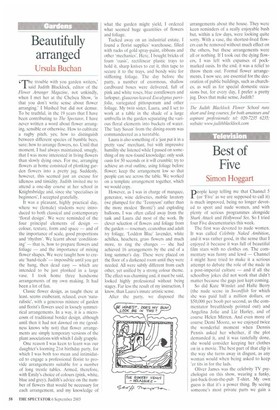Beautifully arranged
Ursula Buchan
irrhe trouble with you garden writers,' 1 said Judith Blacklock, editor of the Flower Arranger Magazine, not unkindly, when I met her at the Chelsea Show, is that you don't write sense about flower arranging.' I blushed but did not demur. To be truthful, in the 19 years that I have been contributing to The Spectator, I have never written a word about flower arranging, sensible or otherwise. How to cultivate a rugby pitch, yes; how to distinguish between different species of bumble bees, sure; how to arrange flowers, no. Until that moment, I had always maintained, smugly. that I was more interested in living flowers than slowly dying ones. For me, arranging flowers at home consisted of plonking garden flowers into a pretty jug. Suddenly, however, this seemed just an excuse for idleness and timidity. Judith invited me to attend a one-day course at her school in Knightsbridge and, since she 'specialises in beginners', [accepted gratefully.
It was a pleasant, highly practical day, where we (female) students were introduced to both classical and contemporary 'floral design'. We were reminded of the four principal elements of design — colour, texture, form and space — and of the importance of scale, good proportions and 'rhythm'. We learnt about 'conditioning' — that is, how to prepare flowers and foliage — and the importance of mixing flower shapes. We were taught how to create -hand-tieds' — impossible until you get the hang, then dead easy — which are intended to be just plonked in a large vase. I took home three handsome arrangements of my own making. It had been a lot of fun.
Classic flower design, as taught there at least, seems exuberant, relaxed, even 'naturalistic', with a generous mixture of garden and florist's flowers used in loosely symmetrical arrangements. In a way, it is a microcosm of traditional border design, although until then it had not dawned on me (goodness knows why not) that flower arrangements are simply temporary versions of the plant associations with which I daily grapple.
One reason I was keen to learn was our daughter's looming 21st birthday party, for which I was both too mean and intimidated to engage a professional florist to provide arrangements suitable for a number of long trestle tables. Armed, therefore. with Emily's choice of colours (pink, white. blue and grey), Judith's advice on the number of flowers that would be necessary for each arrangement, and my knowledge of what the garden might yield, I ordered what seemed huge quantities of flowers and foliage.
Tucked away on an industrial estate, I found a florist supplies' warehouse, filled with racks of gold spray-paint, ribbons and other 'mechanics'. Here, I bought bricks of foam 'oasis', rectilinear plastic trays to hold it, sharp knives to cut it, thin tape to secure it to the trays, and bendy wire for stiffening foliage. The day before the party, a number of enormous, shallow cardboard boxes were delivered, full of pink and white roses, blue cornflowers and larkspur, glaucous-leaved Eucalyptus parvifolia, variegated pittosporum and other foliage. My twin sister, Laura. and I set to work at a table in the shade of a large umbrella in the garden separating the various floral elements into buckets of water. The 'lazy Susan' from the dining-room was commandeered as a turntable.
Laura is also something of a 'just put it in a pretty vase' merchant, but with impressive humility she listened while I passed on something of my new-found knowledge: only soak oasis for 50 seconds or it will crumble; try to achieve an oval outline, using foliage before flower; keep the arrangement low so that people can see across the table. We worked on a template arrangement together, which we would copy.
However, as I was in charge of marquee, generator, wine deliveries, mobile lavatory (we plumped for the 'Tennyson' rather than the more modest 'Brontë') and exploding balloons, I was often called away from the task and Laura did most of the work. By clever selection of flowers and foliage from the garden — rosemary, ceanothus and adult ivy foliage, `Loddon Blue' lavender, white achillea, heuchera, grass flowers and much more, to ring the changes — she had achieved 16 arrangements by the end of a long summer's day. These were placed on the floor of a darkened room until they were needed. All were subtly different from each other, yet unified by a strong colour theme. The effect was charming and, it must be said, looked highly professional without being stagey. Far less the result of my instruction, I know, than Laura's innate artistic sense.
After the party, we disposed the arrangements about the house. They were keen reminders of a really enjoyable bash but. within a few days, were looking quite sorry. With a vase, the shortest-lived flowers can be removed without much effect on the others, but these arrangements were all or nothing. If I took out the dying flowers, I was left with expanses of pockmarked oasis. In the end, it was a relief to throw them out. Formal flower arrangements, I now see, are essential for the decoration of public buildings, such as churches, as well as for special domestic occasions but, for every day, I prefer a pretty jug. Does that make sense, Judith?
The Judith Blacklock Flower School runs short and long courses, for both amateurs and aspirant professionals: tel: 020-7235 6235; website: www.judithblacklock.com










































































 Previous page
Previous page